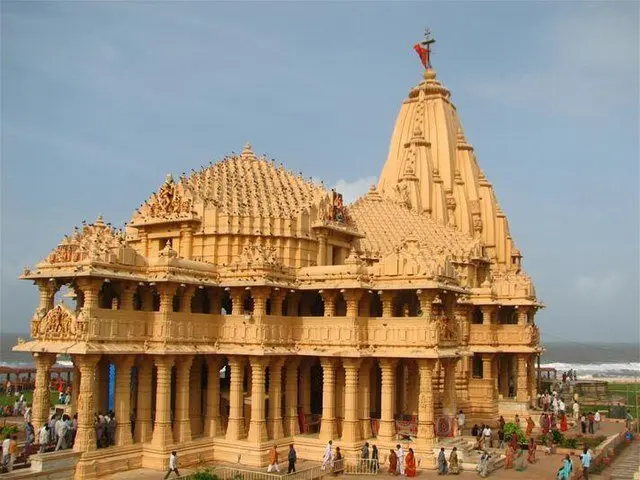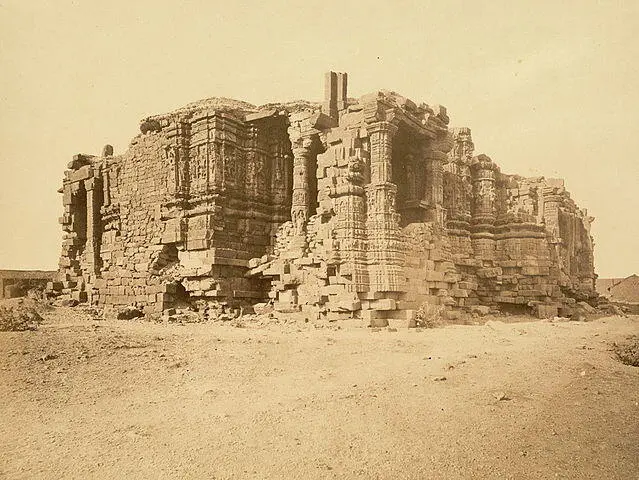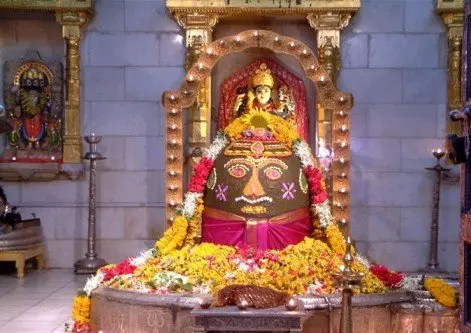
The Somnath Temple in Gujarat is the first of the 12 Jyotirlingas. The area is also popular by the name Deo Patan or Prabhas Kshetra. The Somnath Mandir is one of the most popular Hindu pilgrimages. The temple was attacked and destroyed multiple times by Muslim invaders and rulers in the past but was rebuilt by Hindus. The present Mandir was constructed in 1951 under the orders of the contemporary home minister, Mr. Vallabhbhai Patel.
The Meaning of the Word Somnath:
“Soma” means moon and “natha” means lord. Therefore, Somnath means “The Lord of the Moon,” which is one of the names of Lord Shiva. The Mandir got its name from the story mentioned in the Puranas.
The History of Somnath Temple:
The Somnath Mandir is also known as “eternal shine” because it stands erect to date despite undergoing so many attacks.
The Story of Somnath Jyotirlinga (Shiva Purana, 4.14):
The Moon-god (Soma or Chandra) married 27 daughters of Daksha Prajapati, but he paid more attention to Rohini only. His other 26 wives complained to Daksha about this. Daksha told the Moon-god to give equal attention to all his wives, but he did not listen. The infuriated Daksha cursed him that he would fall prey to the wasting disease. Chandra’s body started wasting immediately, but this was diabolical for the world. Therefore, gods went to Lord Brahma for a solution, who in turn advised Chandra to worship Lord Shiva in the form of a lingam.
Chandra did penance for six months. Propitiated Lord Shiva appeared there in the form of a Jyotirlinga and blessed Chandra. He reduced his curse but did not clear it completely because Chandra had sinned greatly previously. He told him that he would decline day by day in one fortnight and increase steadily in another. For increasing the glory of the region and the moon, Lord Shiva stayed there in the form of Someshwara.
When was the First Somnath Temple Built?
Per the temple website, the first Prana-Pratishtha of the Somnath Jyotirlinga was done on the auspicious third day of the bright half of Shravana month during the tenth Treta Yuga of Vaivaswata Manvantara. The first temple was built by the Moon-god in gold. Ravana rebuilt it in silver, Lord Krishna in sandalwood, and Bhimadeva in sandstone.
Lord Krishna died at Veraval, which is close to Somnath. Arjuna performed the last rites of Lord Krishna at the confluence of the rivers Kapila and Hiranya, which is the site of Somnath temple.
Per the known history, a Chalukya king, Mularaja built the first temple at the site around 997 CE.
Who Destroyed the Somnath Temple?
The temple did not undergo destruction 17 times, as is the common misconception, but about five times by Mahmud of Ghaznavi, Allauddin Khilji, Jafar Khan, Mahmud Begada, and Aurangzeb.
1. The Somnath Mandir was one of the richest temples in ancient times. Mahmud of Ghazni raided and looted the temple in 1024 CE. He also destroyed the Shiva lingam in the temple. He plundered about 20 million dinars. Bhima I was the ruler of the area at that time. The temple was so wealthy at that time that it had 300 musicians, 500 dancing girls, and even 300 barbers. Mahmud of Ghazni conquered the town and temple after a two-day battle in which, it is said, 70,000 defenders died.
According to Alberuni, a Turkey scholar, there was a stone fortress built about a hundred years before Mahmud’s raid within which the lingam was located, presumably to safeguard the wealth of the temple. The idol was especially venerated by sailors and traders. Alberuni also mentions that Durlabha of Multan, presumably a mathematician, computed the year of the raid on Somnath as Shaka 947 (equivalent to A.D. 1025-26).
Most probably, the temple was made of wood at that time.
2. The second destruction of the temple occurred in 1299 by Allauddin Khilji’s army. The idol was later recovered, and the temple was rebuilt by Mahipala I, the king of Saurashtra.
3. In 1395, the governor of Gujarat, Jafar Khan, destroyed it for the third time.
4. In 1451, Mahmud Begada, who was the Sultan of Gujarat at that time, desecrated it. He built a mosque at the site.
5. In 1665, Aurangzeb ordered to destroy it but did not destroy it completely. In 1702, he prohibited Hindus to worship there, otherwise threatening to demolish the temple completely.
Marathas Rebuilt the Temple:
After the death of Aurangzeb, the Mughal Empire weakened, and the Maratha Empire spread to the north. Ahilyadevi Holkar of Indore rebuilt the temple.
Proclamation of the Gates Incident:
Edward Law, who was the 1st Earl of Ellenborough, issued a proclamation in 1842 related to the gates of the Somnath Temple that were looted by Mahmud of Ghazni. This proclamation is known as the Proclamation of the Gates. By it, he ordered the British Army deployed in Afghanistan to visit Ghazni and bring back the sandalwood gates from the tomb of Mahmud of Ghazni. The British Army followed the orders and brought back the gates, but it was found that the gates were not made of sandalwood and had no Indian connection. They were made of Deodar wood that is native to Afghanistan. Those gates were placed in the storeroom of Agra Fort and lie there to date.
The proclamation was strongly opposed in the British parliament and was considered an attempt to appease Hindus by Edward Law. It was also claimed that no such incident of Mahmud taking away gates of the Somnath Mandir had happened. There was no historical proof and could only be an invention of folk tradition.
The Final Reconstruction during 1950-51:

Mr. Vallabhbhai Patel ordered the reconstruction of the Somnath Temple in 1947, but the work was completed after his death. Mahatma Gandhi also supported his decision but advised to collect the money from the public instead of using state funds.
There was a mosque present at the site, which was shifted a few kilometers away. The construction took about five years to complete and was inaugurated by the Indian president, Dr. Rajendra Prasad in 1951.
The Old Somnath Temple and New Somnath Temple:
It seems confusing at first that if Ahilyadevi Holkar rebuilt the temple, how could a mosque be there. Actually, she rebuilt the temple at a different site close to the new temple. It is said that Lord Shiva in the form of Jyotirlinga came in her dream; post which she immediately started the reconstruction. Some Hindus believe that the original Shiva lingam was buried there assuming that the original temple would be raided. If Lord Shiva really came in her dream and instructed her to build a temple at that site, then it is quite possible.
Highlights of the Architecture of the Somnath Temple:
1. The temple is built in Chalukya style of temple architecture and is made of sandstones.
2. The masons who built the temple were from the Sompura Salats community. Shri Prabhashankarbhai Oghadbhai Sompura was the chief architect.
3. The temple is situated in such a place that there is no land in a straight line between Somnath seashore and Antarctica.
4. The shikhara of the temple is 15 m high and has an 8.2 m long tall flagpole at the top.
5. The kalasha that tops the shikhara weighs 10 tons.
6. The Banastambha mentions that it stands at a point on the Indian landmass, the first point on land in the north to the South Pole at that particular longitude.
7. The temple is seven-storied and 155 feet tall.
The Shiva Lingam in the Somnath Temple:

According to the Skanda Purana, the Shiva lingam is five-faced, but the current Shiva lingam does not seem to have five faces. Therefore, it might not be the original Shiva lingam. The current Shiva lingam is 4 feet high.
Per some legends, the original Shiva lingam at the temple used to levitate in the air. It is believed that the Shiva lingam was hidden within the hollowness of the Syamantaka Mani. Lord Krishna was accused of stealing this jewel. It is a miraculous jewel that attracts wealth. The stone is also believed to have magnetic properties, which enabled the Shiva lingam to remain suspended in the air.
Where is the Somnath Temple Located?
The Somnath Mandir is located in Veraval in Saurashtra on the western coast of Gujarat at the confluence of the rivers Kapila, Hiranya, and Saraswati.
How to go to Somnath Temple from Ahmedabad?
The distance between Ahmedabad and the Somnath Temple is approximately 410 km. It takes about 8 hours to reach there. You can go by bus, train, flight, or private vehicle. The nearest railway station is at Veraval, which is 6 km away. The closest airport is Diu airport in Diu and Daman. The second closest airport is Porbandar Airport.
Somnath Temple Timings:
Per the temple authority, you can visit the temple between 6 am to 10 pm. It takes anywhere from 10 minutes to 1 hour or more for Darshana, depending on the conditions. A light and sound show takes place daily.
Places to Visit Around Somnath Jyotirlinga:
1. Suraj Mandir.
2. Lakshmi Narayan Temple.
3. Gir National Forest.
4. Bhalka Tirtha.
5. Panch Pandav Caves.
6. Dehotsarga Tirtha.
7. Lord Parashurama Temple.
8. Harihara Vana.
9. Veneshwar Mahadev Mandir.
10. Kamnath Mahadev Mandir.
11. Sana Caves.
12. Shashibhushan Mahadev and Bhidbhanjan Ganpatiji Temple.
13. Prabhas Patan Museum.
14. Triveni Ghat.
15. Somnath Beach.
16. Gita Mandir.
17. Junagadh Gate.
18. Chorwad Beach.
As the moon waxes and wanes, in the same way, the temple is destroyed and rebuilt again. It seems its fate is tied with him.
Reference:
http://www.columbia.edu/itc/mealac/pritchett/00islamlinks/txt_thapar_somnath.html